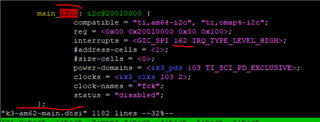Hi guys,
I have an RTC interrupt pin connected to the SoC EXTINTn/GPIO1_31, and I want to use it as a wakeup source from the s2idle state.

The first question is: Should I configure the D16 PIN as GPIO1_31 or leave it at the default value EXTINTn?
The second question is: Are interrupts controlled by GIC_SPI?
The third question is: What is the interrupt number of the RTC device on I2C bus 1? Should it be an I2C bus 1 device?"

TRM: Table 10-12. GIC Interrupt Connection

The final question is: Is IRQ_TYPE_EDGE_FALLING supported by the GIC?"

Thanks,
Sean




